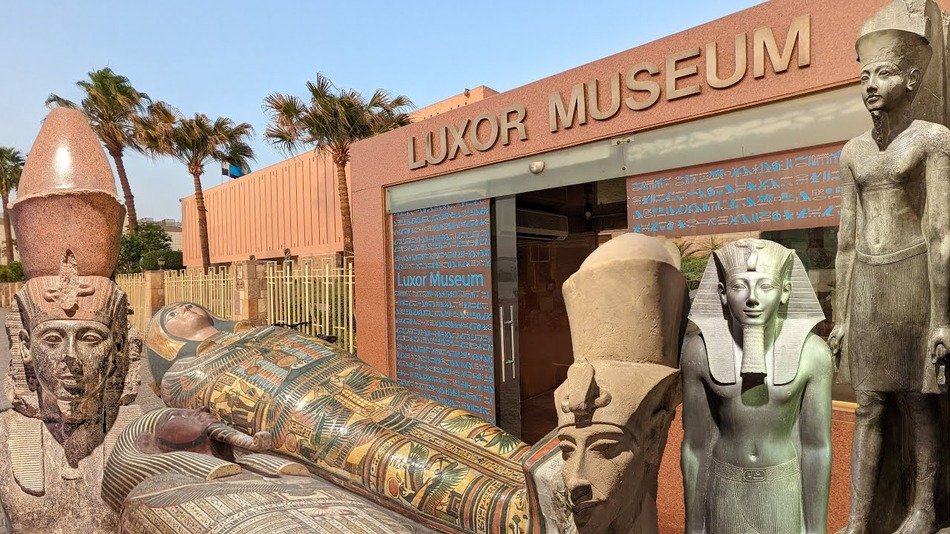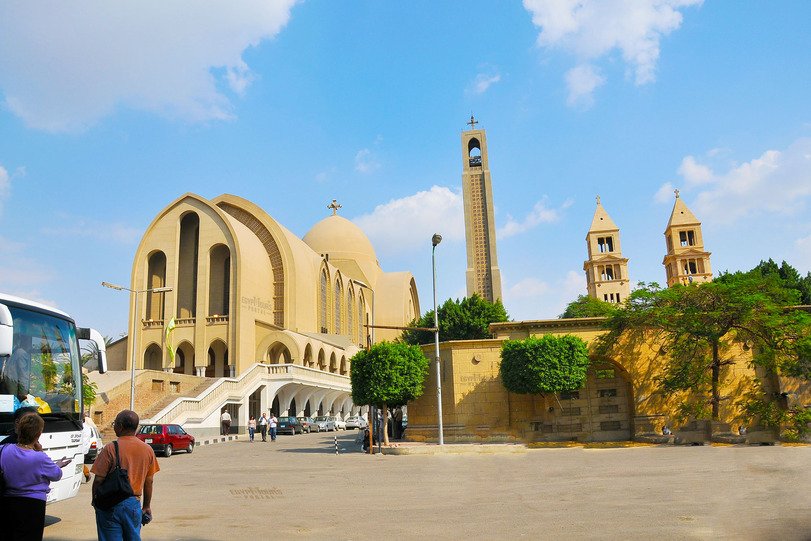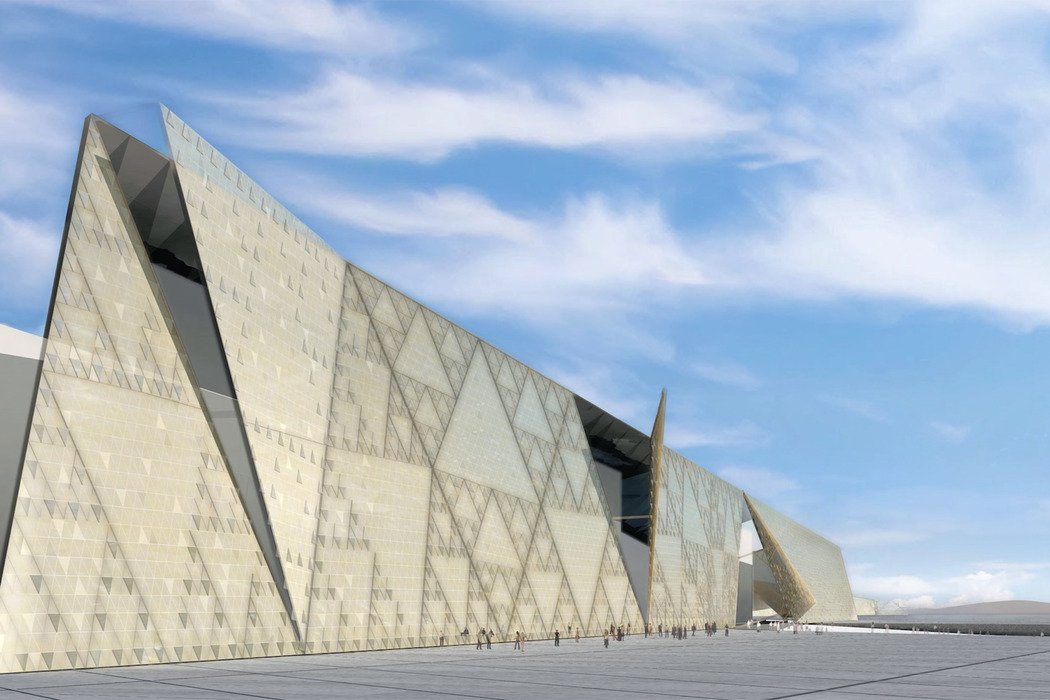12 Best Museums to Visit in Egypt to discover the wonders of Egypt’s rich heritage by visiting its top attractions. Admire the awe-inspiring ancient artifacts displayed at the Egyptian Antiquities Museum and the King Tutankhamun Museum. Gain insight into the ancient art of boat-building at the Giza Solar Boat Museum and learn about the historical significance of papyrus at the Egypt Papyrus Museum.
Immerse yourself in the captivating history at the Luxor Museum and the Bibliotheca Alexandrina. Unearth Alexandria’s fascinating past at the Alexandria National Museum and immerse yourself in the vibrant markets of Cairo at Khan-el-Khalili. Experience the spiritual beauty of landmarks such as the Mosque of Mohamed Ali, Old Cairo, and the Coptic Orthodox Church of Alexandria. Egypt warmly welcomes you to embark on a mesmerizing journey through millennia of history and culture.
Egyptian Antiquities Museum

Situated in the heart of Cairo, Egypt, the Egyptian Antiquities Museum, also known as the Museum of Cairo, stands as a symbol of the country’s rich heritage. Housing an extensive collection of over 120,000 historic artifacts, this renowned museum offers a captivating journey through Egypt‘s illustrious past. From prehistoric relics to exquisite treasures from the golden era of kingship, the museum showcases the remarkable cultural and artistic achievements of this ancient civilization. A visit to this treasure trove is a must for anyone with a passion for history and a desire to delve into the captivating world of ancient Egypt.
King Tutankhamun Museum

The world’s most famous mummy, that of the Egyptian ruler King Tutankhamun, is meticulously preserved in the Grand Egyptian Museum of Cairo, often colloquially referred to as the King Tutankhamun Museum. Encompassing a vast expanse of 480,000 square meters, the museum is strategically located a few miles south of the Pyramid of Giza, emerging as a premier destination among Egypt’s top-rated places to visit.
Functioning as an intricate chronicle of the Ancient Egyptian reign of Pharaohs, the King Tutankhamun Museum immerses visitors in the rich history and cultural legacy of this remarkable civilization. Among its treasures is the carefully restored throne of King Tutankhamun, housed at the conservation center of the museum since August 2019, adding to the awe-inspiring collection that continues to captivate the world.
Giza Solar Boat Museum

The Giza Solar Boat Museum is a fascinating site located near the Great Pyramid of Giza in Egypt. It houses a reconstructed ancient Egyptian boat, known as the Solar Boat or Khufu Ship. The boat was discovered in 1954 in a pit near the Great Pyramid and is believed to have been built for Pharaoh Khufu (also known as Cheops) to transport him in the afterlife.
The boat is an impressive piece of ancient engineering, made of cedar wood and intricately assembled with thousands of pieces. It’s a testament to the advanced craftsmanship of the ancient Egyptians. The museum itself was built to protect and showcase this remarkable archaeological find.
Visitors to the museum can see the reconstructed boat, which is displayed in a specially designed environment to preserve it. The museum also provides information about the boat’s history, construction, and significance in ancient Egyptian beliefs about the afterlife. It’s a must-visit for anyone interested in ancient Egyptian history and culture.
Egypt Papyrus Museum

Egypt boasts an array of museums that showcase its rich cultural heritage, and among these, the Papyrus Museum stands out as a unique repository of ancient knowledge.
Located in Cairo, the Papyrus Museum is a treasure trove of historical significance. It houses a collection of ancient papyrus scrolls, some dating back thousands of years. Papyrus, derived from the reed plant of the same name, served as the primary writing material in ancient Egypt, capturing everything from religious texts to administrative records and personal documents.
What makes this museum particularly captivating is its diverse assortment of these ancient scrolls. Visitors can witness firsthand the evolution of writing, language, and art through the various scripts, drawings, and hieroglyphics meticulously preserved on these delicate papyrus sheets.
The museum not only showcases the raw material itself but also delves into the process of creating papyrus. Visitors can learn about the ancient Egyptian methods of making this paper-like material, witnessing demonstrations or exhibits detailing the intricate steps involved in its production.
Furthermore, the Papyrus Museum offers insights into the daily life, beliefs, and customs of ancient Egyptians through the texts and illustrations found on these scrolls. Visitors can explore excerpts from the Book of the Dead, religious texts guiding the deceased through the afterlife, or marvel at the beautifully illustrated tales and mythologies that have endured for millennia.
For history enthusiasts, scholars, and anyone fascinated by the ancient world, the Papyrus Museum serves as a portal to the past, preserving and presenting the invaluable written heritage of Egypt in an engaging and educational manner. It’s a testament to the enduring legacy of a civilization that continues to intrigue and captivate the world.
Luxor Museum

The Luxor Museum, located in Kornish El Nile, Luxor City, Luxor, Luxor Governorate, Egypt, is home to a remarkable assortment of ancient antiquities that span from the Old Kingdom to the Mamluk period. The museum’s collection is primarily sourced from the Theban necropolis and temples, offering visitors a visually stunning display of masterpieces that beautifully depict the rich history of the region.
Within the Luxor Museum, one can find an array of impressive collections, including a intricately carved figurine of Tuthmosis III, a limestone relief portraying Tuthmosis III, and an exquisite alabaster statue of Amenhotep III. These artifacts take visitors on a captivating journey, allowing them to explore the artistic and cultural legacy of ancient Egypt.
Bibliotheca Alexandrina – Library in Alexandria

The Bibliotheca Alexandrina, established in 2002, serves as a remarkable center of knowledge. Boasting an impressive collection of over 1.5 million educational resources, this library is a top choice for both avid readers and students.
In addition to its vast array of books, the Bibliotheca Alexandrina also offers a captivating planetarium, four museums, and six specialized libraries. This extensive educational gallery truly embodies a dynamic environment for learning and cultural exploration, making a significant contribution to Egypt’s intellectual landscape.
Situated in Al Azariya WA Ash Shatibi, Qesm Bab Sharqi, Alexandria Governorate 21526, Egypt, the Bibliotheca Alexandrina stands as a beacon of inspiration and enlightenment.
Alexandria National Museum

The Alexandria National Museum, situated in the heart of Alexandria, is a captivating cultural institution that offers a fascinating journey through the history and heritage of this ancient city.
This museum is a treasure trove that narrates the story of Alexandria, a city renowned for its pivotal role in the ancient Mediterranean world. The museum’s exhibits span various eras, starting from the prehistoric times of Egypt through the Hellenistic, Roman, and Islamic periods, showcasing the diverse cultural tapestry that defines Alexandria’s rich past.
One of the highlights of the museum is its collection of artifacts recovered from underwater archaeological expeditions in the Eastern Harbor of Alexandria. These submerged treasures offer glimpses into the city’s illustrious past, revealing relics from the legendary Lighthouse of Alexandria, one of the Seven Wonders of the Ancient World, and other submerged monuments.
Visitors can explore an array of artifacts, including statues, pottery, jewelry, and everyday items, each providing insight into the lives, beliefs, and customs of the various civilizations that thrived in Alexandria throughout history. The museum’s exhibits are thoughtfully curated, offering a comprehensive narrative that intertwines the city’s Pharaonic, Greco-Roman, and Islamic influences.
In addition to its impressive collection, the Alexandria National Museum itself is housed in a historic building, the former Al-Saad Bassili Pasha Palace, adding to the allure of the visitor experience. The architecture itself speaks volumes about the city’s heritage.
For history enthusiasts, scholars, and tourists eager to immerse themselves in the rich history of Alexandria, the Alexandria National Museum stands as a cultural gem, preserving and presenting the legacy of this ancient metropolis in a compelling and educational manner
The Egyptian Museum

The Egyptian Museum, founded by Auguste Mariette in 1857 and relocated to its current site in 1897, is a truly captivating attraction in Cairo. Its extensive collection of exhibits and artifacts entices visitors, particularly history enthusiasts, who will be amazed by the vast array of treasures on display.
With an impressive collection of approximately 120,000 artifacts, the museum stands as a testament to the glorious era of ancient Egypt. Among its remarkable highlights are the Tutankhamun Galleries, which showcase exquisite jewelry, pottery, mummies, sarcophagi, and the iconic treasures of King Tutankhamen.
Situated in Midan al-Tahrir, Downtown Cairo, Egypt, the Egyptian Museum is a must-visit destination for anyone seeking to delve into the rich history and heritage of this ancient civilization.
Khan-el-Khalili

Khan el-Khalili is a bustling and historic souk (market) located in the heart of Islamic Cairo, Egypt. This vibrant marketplace has been a center of trade and commerce for centuries, dating back to the 14th century.
The Khan el-Khalili market is a labyrinth of narrow alleys and lanes lined with shops, stalls, and vendors selling an eclectic array of goods. From intricately crafted jewelry, colorful textiles, spices, traditional handicrafts, to exquisite antiques, the market offers a diverse range of products, showcasing the skilled craftsmanship and rich cultural heritage of Egypt.
One of the joys of visiting Khan el-Khalili is the immersive experience it offers. As you navigate the maze-like streets, you’ll encounter the sights, sounds, and aromas that define this vibrant marketplace. The merchants are often eager to engage visitors, creating a lively atmosphere where bargaining is an integral part of the shopping experience.
Amidst the shops, you’ll find traditional coffeehouses, known as “ahwas,” where you can take a break, sip some Egyptian tea or coffee, and soak in the ambiance while watching locals and tourists alike pass by.
The Khan el-Khalili market is not just a place for shopping; it’s a cultural hub where history and modern life intersect. Its historical significance and architectural charm make it a must-visit destination for travelers seeking to immerse themselves in Cairo’s vibrant culture and heritage.
From the scent of spices wafting through the air to the intricate designs of the merchandise, Khan el-Khalili offers a sensory experience that encapsulates the essence of Egypt’s bustling markets and serves as a reminder of the country’s enduring traditions in trade and commerce.
Mosque of Mohamed Ali

The Mosque of Mohamed Ali, also known as the “Alabaster Mosque,” is a significant Islamic monument situated within the Citadel of Cairo. With its origins dating back to the 19th century, this mosque holds great appeal for both those seeking spiritual solace and those with a keen interest in architectural marvels.
Distinguished by its twin minarets and captivating outline, this mosque stands as a testament to the grandeur of 19th-century construction. The Mosque of Mohamed Ali showcases an exquisite Ottoman-style architectural design, complemented by lavishly adorned interiors.
Situated in Al Abageyah, El-Khalifa, Cairo Governorate, Egypt, this mosque is a must-visit destination for those who appreciate the fusion of spirituality and architectural brilliance.
Old Cairo

Old Cairo, with its rich history and abundance of churches, offers a captivating glimpse into Egypt’s glorious past. It is undeniably a must-see destination in Cairo. Within its boundaries lie several remarkable historical sites that bear witness to the Greco-Roman era. Additionally, Old Cairo is the birthplace of Babylon, believed to have been established around 525 BCE.
The remnants of a Roman fortress can still be admired, showcasing its enduring presence through the white and red bricks. There are numerous captivating attractions to explore, including the Coptic Museum, Church of the Virgin Mary, Ben Ezra Synagogue, and many more. These architectural marvels provide invaluable insights into the vibrant culture of Egypt.
Situated on Sharia Mar Girgis, south of Downtown, Old Cairo awaits your discovery.
Coptic Orthodox Church of Alexandria is one of the 12 Best Museums to Visit in Egypt

The Coptic Orthodox Church of Alexandria is an Oriental Orthodox Christian church that was historically the headquarters of the Coptic Orthodox Church, led by the Pope of Alexandria.
According to tradition, this church was built on the exact spot where Saint Mark, the evangelist and apostle, established a church in the 1st century. It features a remarkable basilica-style architectural design adorned with beautiful Coptic engravings.





